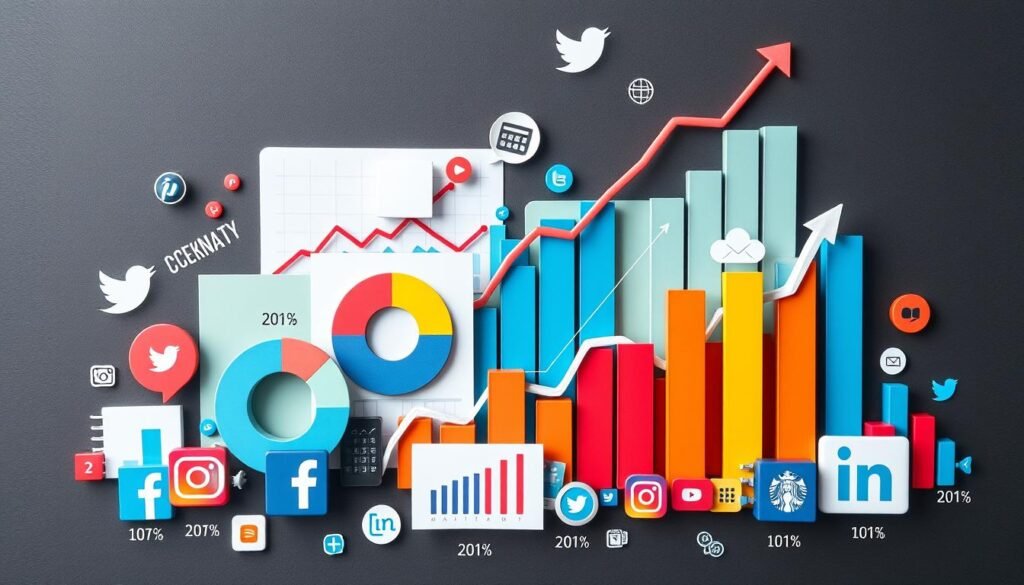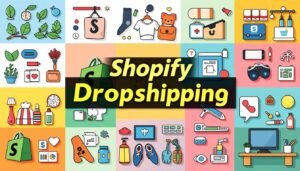Are you using social media to grow your brand? With over four billion users, it’s a key marketing tool. People spend 15% of their time on social media, a great chance to reach your audience.
This guide covers social media marketing basics. We’ll talk about strategy, content, influencer partnerships, and analytics. It’s all about boosting your brand, getting more website visits, and making sales.
Key Takeaways
- Social media marketing is a powerful way to reach and engage with your target audience, with over 4 billion users worldwide.
- Consumers spend an average of 15% of their time on social media, making it a prime opportunity for businesses to connect with their audience.
- Effective social media marketing can help boost brand awareness, drive website traffic, and even lead to increased conversions.
- Developing a comprehensive social media strategy is crucial for achieving your marketing goals and standing out in a crowded digital landscape.
- Leveraging the right social media platforms, creating engaging content, and utilizing advanced analytics can help you maximize the impact of your social media efforts.
What is Social Media Marketing?
Social media marketing uses big social media sites to reach lots of people. It’s about making content, talking to followers, and using special features to meet your goals.
Definition and Overview
It’s about promoting your business on social media. This means keeping your profiles up, posting interesting stuff, and talking to people. It also means growing a community around your brand.
Benefits and Key Stats
Social media marketing has many benefits. It makes your business seem more human, brings in traffic and leads, and grows your brand. Here are some important stats:
- The average US adult spends 2.25 hours on social media every day.
- Over 70% of people who have a positive experience with a business on social media will recommend that business to their networks.
- Facebook users click on 12 Facebook ads on average every month.
- 81% of people use Instagram to research products and services.
- Nearly 80% of Twitter users feel more positive about a business when they get a response to their tweet.
- 4 out of 5 people on LinkedIn drive business decisions.
- 46% of TikTok users engage in the app without any other distractions.
These stats show how powerful social media marketing is. It can reach and engage your audience, build loyalty, and increase sales.

Developing a Social Media Marketing Strategy
Creating a good social media marketing strategy starts with clear goals. You might want to boost your brand, get more leads, or offer great customer service. It’s also key to know who you’re talking to – which platforms they use, when, and what they like.
Setting Clear Goals and Objectives
First, define your social media marketing goals. Think about things like:
- Getting more people to know your brand
- More people visiting your website and becoming leads
- Making customers happier and more loyal
- More sales and money coming in
Make your goals SMART (Specific, Measurable, Achievable, Relevant, Time-bound). This way, you can see how well you’re doing and if your social media is working.
Understanding Your Target Audience
To make your social media better, you need to know your target audience. Look at things like:
- Who they are (age, gender, where they live, what they like)
- Which social media they like best
- When they’re online and what they do there
- What problems they face and what they want to achieve
This info helps you make content that speaks to them. It also helps you use social media in the best way possible.

“A well-defined social media marketing strategy is the foundation for success in the digital age. By setting clear goals and understanding your target audience, you can create a roadmap to elevate your brand and drive meaningful engagement.”
Creating a Social Media Marketing Plan
Making a good social media marketing plan is key for businesses. It helps them grow their brand and connect with people. First, pick the right social media platforms for your audience and resources. Then, set clear goals and make a detailed content calendar for posting.
Choosing the Right Platforms
Finding the best social media platforms for your business is important. Think about your audience’s likes, the best content for each platform, and how much your team can handle. Sites like Facebook, Instagram, Twitter, and LinkedIn are great but choose wisely based on your goals.
Developing a Content Calendar
Next, make a solid content calendar. Plan and schedule posts to keep your social media fresh and engaging. Mix up your content with blog posts, photos, polls, and customer stories to keep people interested.
| Social Media Platform | Recommended Posting Times |
|---|---|
| Monday, Wednesday, Thursday, and Friday between 11 a.m. and 1 p.m. | |
| Wednesday, Thursday, and Friday between 12 p.m. and 4 p.m. | |
| Tuesday, Wednesday, and Thursday between 5 p.m. and 6 p.m. | |
| Monday, Tuesday, Wednesday, and Thursday around noon |
By matching your social media marketing plan with your business goals, you can use social media well. Track important metrics and keep improving your plan. This way, you can grow your business and meet your marketing targets.

Content Creation for Social Media
Social media content is key for any good digital marketing plan. Businesses need to make engaging, valuable content for their audience on different platforms. They should mix up their content to keep people interested and coming back.
Types of Engaging Content
There’s no single way to make great social media content. Businesses must know what their audience likes. Some top content types include:
- How-to guides and tutorials
- Industry news and thought leadership pieces
- Data-driven infographics and charts
- Interactive polls and surveys
- Behind-the-scenes company updates
Repurposing and Recycling Content
Marketers use tricks like repurposing content to keep things fresh. They might turn a blog post into social media updates or share user content. This way, they get more out of their content and keep followers engaged.
| Content Type | Best Platforms | Key Benefits |
|---|---|---|
| Long-form written content (e.g., blogs, articles, guides) | LinkedIn, Facebook | Showcases industry expertise, generates leads |
| Shorter text-based updates | Allows for quick, timely engagement | |
| Visual content (e.g., images, videos, infographics) | Instagram, TikTok, YouTube | Increases engagement, brand awareness |
| User-generated content (e.g., customer photos, testimonials) | Instagram, Facebook | Builds trust, encourages community participation |
By mixing up Social Media Content Creation and reusing Content Types, businesses stay fresh and engaging. This keeps their Content Repurposing strategies in line with what their audience likes.

Social Media Marketing
Social media marketing is key in today’s digital world. It helps businesses reach more people and sell more. It’s about sharing new products and talking to customers online.
One big plus is you can see how well it works. Unlike old-school ads, you can track your success. This lets you make your marketing better over time.
Choosing the right platforms is important. Facebook is great for many businesses. YouTube is perfect for videos. Twitter is good for quick updates. TikTok is for short videos and younger people.
Having a content plan is vital. It helps keep your followers interested. You can use the same content in different ways to reach more people.
Paid ads can also help. They let you target specific groups. This means your message gets to the right people.
To see how well you’re doing, use tools like Google Analytics. Social media sites also have their own tools. These help you understand how people are interacting with your content.
In short, social media is crucial for any business. It helps you connect with your audience and grow. Using platforms like Facebook, Twitter, and Instagram can really help your brand.

Paid Social Media Advertising
Using paid social media advertising can really help your brand online. First, find out who you want to reach. Then, set clear goals for your ads. Choose the best social media ad formats to grab their attention.
Understanding Ad Formats and Targeting
Social media has many ad types, like story ads and video ads. Each one is good for different goals and what people like. Knowing these social media ad formats helps make your ads better and more fun.
Good social media ad targeting uses special tools on sites like Facebook and Instagram. You can find exactly who you want to see your ads, based on where they live, how old they are, and more.
Managing and Optimizing Ad Campaigns
Managing your paid social media advertising well is key. Watch your ad’s performance closely. Look at things like how much each click costs and how much money you make back. Use this info to make your ads better and get more value.
Linking your social media ad optimization to your big marketing plan makes your ads even stronger. This helps you meet your business goals.

“Paid social media advertising is a game-changer for brands looking to reach their target audience and drive measurable results.” – [Expert Name], Social Media Marketing Strategist
Influencer Marketing
In the fast-changing digital world, influencer marketing is a key way for brands to reach their audience. It involves working with people who share your brand’s values and have a lot of followers. This can open up new markets, make your brand more credible, and lead to more sales.
Identifying and Collaborating with Influencers
Finding the right influencers is crucial for influencer marketing success. Look at different types of influencers, from those with just a few thousand followers to those with millions. Each type can help your marketing in different ways.
- Nano-influencers have deep knowledge and strong connections, leading to high engagement.
- Micro-influencers are seen as experts in their fields, offering a good balance of reach and interaction.
- Macro-influencers bring a lot of visibility, while mega-influencers have a huge global audience.
When working with influencers, aim for real partnerships that match your brand’s values. Make sure to check if their followers are real, using tools like InstaCheck to verify their authenticity.
“Authenticity is considered crucial in successful influencer marketing campaigns.”
Adding influencer marketing to your digital plan can help you tap into the trust and loyalty influencers have built. This can boost your brand’s visibility, engagement, and return on investment.
Analytics and Metrics for Social Media
It’s key to check if your social media marketing is working. You should watch reach, impressions, engagement, follower growth, and conversion rates. Also, social media monitoring and listening helps see how people see your brand. It shows what your audience likes and how you compare to others.
Key Performance Indicators (KPIs)
Engagement rate shows how much people interact with your posts. You can find it by adding likes, comments, shares, and saves. Then, divide by followers and multiply by 100.
Likes and reactions show people like your content. Comments show how people feel about it. Watching comment growth shows more people are talking to you. Shares mean people want to share your stuff, showing they really like your brand.
Social Media Monitoring and Listening
Reach tells you how many people see your posts. It breaks down followers and non-followers. Impressions count how many times people see your content, even if it’s the same person.
| Metric | Description | Importance |
|---|---|---|
| Social Share of Voice (SSoV) | Compares your brand’s social media talks to competitors. Shows your brand’s visibility. | Shows your brand’s presence and power in your field. |
| Conversion Rate | Tells you how often social content leads to action. Shows your campaigns’ value. | Measures if your social media helps reach business goals. |
| Click-Through Rate (CTR) | Shows how often people click on your links. Indicates interest in your offers. | Helps see if your content is relevant and appealing. |
| Cost-per-Click (CPC) | Shows how much you spend per click. Helps you spend your ad budget wisely. | Helps you make your ads more cost-effective. |
Keep checking and tweaking your plan with these social media analytics and social media metrics. This keeps your social media marketing on track and effective.
“50% of business leaders say social media data and insights inform their company’s business strategy as reported in The 2023 State of Social Media report.”
Community Management and Engagement
Social media has changed how brands talk to their fans. It’s key for any good social media plan. By answering comments, both good and bad, brands show they care. They also build strong bonds with their followers.
Creating content that engages and special offers can make fans even more loyal. This helps a brand grow and get more people to know about it.
Responding to Comments and Mentions
Talking to your followers on social media is very important. It helps build trust and loyalty. When you quickly answer comments, it shows you value your customers’ opinions.
This not only solves problems but also makes people want to talk more. It shows your brand really cares about its community.
Building Loyalty and Advocacy
Creating a strong community around your brand is powerful. Give special content or rewards to your most active followers. This turns them into brand champions who will share your business with others.
This kind of word-of-mouth can bring in new customers and make your brand more known.
| Community Management Strategies | Key Benefits |
|---|---|
| Responding to Comments and Mentions | Builds trust, improves customer service, encourages further engagement |
| Fostering Loyal Brand Advocates | Amplifies reach, generates authentic endorsements, boosts brand loyalty |
| Personalized Interactions | Enhances customer experience, strengthens emotional connection, increases brand affinity |
| Leveraging AI and Technology | Improves efficiency, enables scalable community management, provides data-driven insights |
Good community management is key for social media success. By talking to your audience, building loyalty, and using community power, businesses can get more social media engagement. They can also strengthen brand loyalty and improve their community management efforts.
Integrating Social Media with Other Marketing Channels
Social media is a key tool for brands to connect with people today. To get the most out of your marketing, you need to link your social media with other channels. This means combining social media with email, SEO, and ads for a strong, omnichannel experience.
Integrated marketing lets you use each platform’s best features. Social media is great for quick engagement and loyalty. Email marketing is top for conversions and lead nurturing. Together, they offer a better, more personal experience for your audience.
To integrate well, your social media and marketing strategy must match. You might share top content on different platforms or use social media to boost your website or email list. M. Suleman Hussain’s platform has great tips on how to do this.
By mixing social media with email, SEO, and ads, you can make your brand more visible. You’ll also connect better with your audience. The secret is to know what each channel does best and use them together for a strong marketing plan.
“Integrated marketing is not about juggling multiple channels – it’s about creating a cohesive, seamless experience for your customers, regardless of how they choose to engage with your brand.”
Linking social media with other marketing channels is key today. By using each platform’s strengths, you can give your audience a better, more consistent experience. This leads to stronger results and success over time.
Social Media Marketing Tools and Resources
Exploring social media marketing can seem tough. But, with the right tools, you can boost your brand online and get real results. There are many tools out there to help you manage your social media better.
Boost Efficiency with Scheduling and Publishing Tools
Tools like SocialPilot, Buffer, and Hootsuite make sharing content easy. They save you time and keep your brand consistent. These tools also help you track your content’s performance and work with your team.
Unlock Insights with Analytics and Monitoring Tools
Tools like Brandwatch, Mention, and Socialbakers give you important data. They help you see how well your campaigns are doing and understand your audience. This way, you can make your content better and reach more people.
Streamline Engagement and Collaboration
Tools like Sprout Social, Agorapulse, and Sendible help you manage your brand’s message. They make it easy to work together and give your audience a better experience. These tools work well with other social media tools to help you work more efficiently.
| Social Media Marketing Tool | Key Features | Pricing |
|---|---|---|
| Loomly | Content planning, scheduling, and publishing | Plans start at $34/month |
| Canva | Visual content creation, brand kits, and design consistency | Free plan and Pro plan at $12.99/month |
| Buzzsumo | Content discovery, curation, influencer identification, and performance analysis | Plans start at $99/month |
| Mention | Real-time brand monitoring, competitor analysis, and social listening | Plans start at $29/month |
| TapInfluence | Influencer marketing, campaign management, and performance tracking | Pricing available upon request |
Whether you’re new or experienced in social media marketing, the right tools can change your game. Look into the many options and find what works best for you and your budget.
“The key to successful social media marketing is leveraging the right tools and resources to streamline your efforts and amplify your brand’s impact.”
Conclusion
Social media marketing is a strong tool for businesses to grow. It helps them connect with customers and boost their brand. With over 70% of internet users on social networks, it’s a great way to reach people.
Creating a good social media plan is key. Make content that grabs attention and use paid ads and influencers. Also, keep checking and improving your strategy. This way, you can use social media to its fullest.
Mobile devices are now a big part of social media. Over 60% of users access social networks on phones. So, making your social media mobile-friendly is very important.
To succeed in social media, stay quick to change and keep your focus on your audience. Over 90% of marketers use social media for business. And more than 60% say it helped them get new customers. Social media is a powerful tool for businesses to grow and make more money.
FAQ
What is social media marketing?
Social media marketing uses popular social networks to help your brand. It means keeping your profiles up, posting interesting stuff, and talking to your followers. It also means building a community around your brand.
What are the benefits of social media marketing?
It makes your business seem more human. It also helps bring in more traffic and leads. Plus, it boosts your brand’s awareness and helps you connect with customers.
Studies show people spend a lot of time on social media. Over 70% of people recommend a business after a good social media experience.
How do I develop a successful social media marketing strategy?
First, set clear goals and know your audience. Then, plan your social media strategy. Choose the right platforms and set goals.
Make a content calendar to post regularly. This keeps your content fresh and consistent.
What types of content should I create for social media?
Your content should be valuable and interesting. Post often and share helpful information. This can be how-to’s, news, data, polls, and updates about your brand.
How can I use paid advertising on social media?
Paid ads can grow your brand online. First, know who you want to reach. Then, set clear goals for your ads.
Choose the right ad types like story ads or video ads. This helps you reach the right people.
How do I find and collaborate with influencers?
Influencer marketing is powerful. Find influencers who match your brand and have followers. This can bring in new people and make your brand more credible.
What metrics should I track for my social media marketing efforts?
Tracking your success is key. Look at reach, impressions, engagement, and follower growth. Also, check conversion rates.
Listening to what people say about your brand is important. It shows how you’re doing compared to others.
How important is community management in social media marketing?
It’s very important. Answering comments and mentions shows you care. It builds trust and loyalty.
Engaging content and special offers can turn followers into brand advocates. This helps your brand grow.
How can I integrate social media marketing with my other marketing efforts?
Social media works best with other marketing. Use it with email, SEO, and ads for a complete experience. This makes your marketing more effective.
What tools and resources can I use to manage my social media marketing strategy?
You’ll need tools for managing your social media. Use platforms for scheduling, analytics for tracking, and tools for creating content. These help you stay organized and effective.







